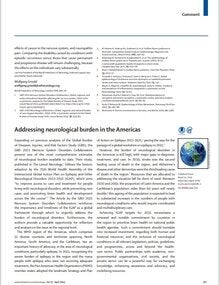Addressing neurological burden in the Americas

|
The WHO region of the Americas, which comprises 51 diverse countries and territories spanning North America, South America, and the Caribbean, has an important history of advocacy in the area of neurological conditions, particularly epilepsy. In 2011, recognising the severe burden of epilepsy in the region and the many people with epilepsy who were not receiving adequate treatment, the Pan American Health Organization (PAHO) member states adopted the landmark Strategy and Plan of Action on Epilepsy 2012–2021, paving the way for the passage of a global resolution on epilepsy in 2015. However, the burden of neurological disorders in the Americas is still high, with major gaps in diagnosis, treatment, and care. In 2019, stroke was the second leading cause of death in the region, and Alzheimer's disease and other dementias were the third leading cause of death in the region.5 Resources that are allocated to addressing the situation fall far short of need. Between 2020 and 2050, the proportion of Latin America and the Caribbean's population older than 60 years will nearly double; this ageing of the population is expected to lead to substantial increases in the numbers of people with neurological conditions who would require coordinated and multidisciplinary care. |
